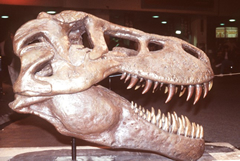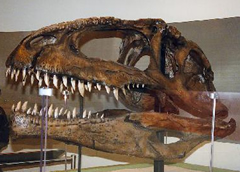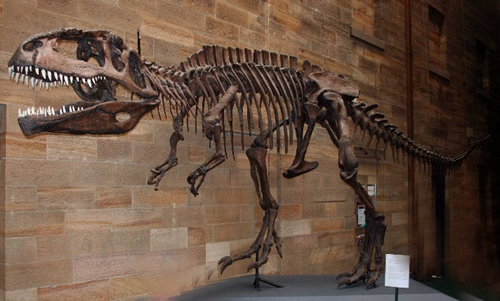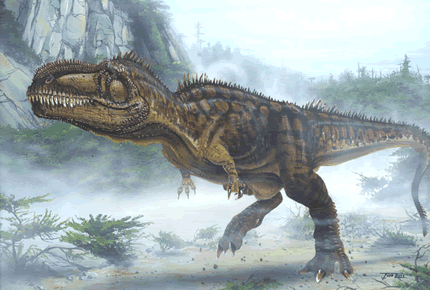Giganotosaurus carolinii - Saurischian Dinosaurs
Homepage > Saurischian Dinosaurs - Giganotosaurus carolinii
(jig-an-oh-toh-sor-uhss)
"Giant Southern Lizard"
Describer Fraas, 1908 / Seeley, 1869
Also Known As --
Type of Species carolinii
Order Saurischia
SubOrder Theropoda
InfraOrder --
Micro-Order --
Family Carcharodontosauridae
Size 52 feet (16 meters) long
Period Late Cretaceous, 100 million years ago
Fossilsite Argentina
Diet Carnivore
Giganotosaurus carolinii lived during the Late Cretaceous period, in what is now Argentina. Giganotosaurus is one of the largest carnivores ever discovered. It grew up to 52 feet in length and weight about 8 tons. Giganotosaurus measured 12 tall at the hips. It was a bipedal carnivore, that possessed enormous jaws with 8 inch long serrated, dagger like teeth for slashing and slicing. Its skull was 6 feet long. Giganotosaurus is seven feet longer and perhaps a ton heavier than the biggest known theropod giants, Tyrannosaurus and Carcharodontosaurus.


The skull on the left belongs to Tyrannosaurus rex, the skull to the right belongs to Giganotosaurus carolinii. The difference on their teeth is that Tyrannosaurus' were massive, like a railroad spike. Tyrannosaurus teeth were meant to crush and destroy its opponent. These teeth would go thru flesh and bone. Some of these teeth were as long as 12 inches. Its jaws were 16 times stronger than an alligator. Its teeth were solidly anchored to withstand pressure from every direction during an attack. On the other hand, Gigantosaurus teeth were smaller, they were designed more to slice and rip flesh from its victims. Even though Gigantosaurus may have been bigger and heavier than Tyrannosaurus rex, the title of the ultimate predator to ever walk the Earth belongs to Tyrannosaurus rex.
Discovery
The first discovery consisted of an incomplete skeleton. With this skeleton
paleontologist could tell that this animal was related to Allosaurus and
specially, Carcharodontosaurus. But having that the skeleton was incomplete,
the estimates of its size were far from conclusive. Since 1995, a number
of new discoveries have been made. In one case several Giganotosaurus
skeletons were discovered close together, suggesting that these animals
may have hunted in packs.

Rodolfo Coria, a paleontologist from the Carmen Funes Museum in Neuquen, Argentina, excavated the Giganotosaurus from the Patagonia region of Argentina (in southern Argentina), which was originally (in 1994) found by a local auto mechanic whose hobby is hunting dinosaur bones. In honor of the discoverer, Ruben Carolini, the huge dinosaur has been named Giganotosaurus carolinii. It was named by Coria and Salgado in 1995.

Image courtesy of Todd Marshall